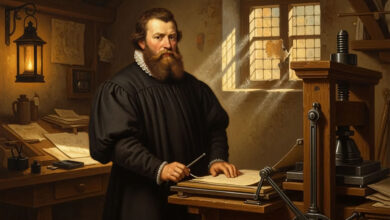Millard Fillmore Biography
Millard Fillmore, the 13th President of the United States, was born on 7 January 1800 in a log cabin in Moravia, Cayuga County, New York. He was the second of nine children born to Nathaniel Fillmore and Phoebe Millard. His family was of modest means, and he grew up in poverty on the harsh frontier lands of upstate New York. Unlike many of his predecessors, Fillmore had no privileged background, and his early years were spent labouring on the family farm. His parents placed a strong emphasis on hard work and self-reliance, qualities that would define his career and political philosophy.
Fillmore’s formal education was extremely limited in his youth. The rural setting in which he was raised offered few educational opportunities, and he had little access to schooling. Determined to better himself, he took it upon himself to study whenever possible. At the age of 14, he was apprenticed to a clothmaker, a trade he found difficult and unsatisfying. During this time, he became increasingly interested in learning, acquiring books to educate himself. Recognising his potential, a local judge named Walter Wood took Fillmore under his wing and encouraged him to pursue a legal career.
With great determination, Fillmore worked his way up from humble beginnings. He attended the New Hope Academy, where he studied diligently to improve his knowledge. Although he had little formal schooling, his perseverance paid off, and he eventually secured a position as a clerk in a law office. He studied law while working and was admitted to the bar in 1823. Soon after, he established his own law practice in East Aurora, New York, where he gained a reputation for honesty, diligence, and sound judgement. His success as a lawyer allowed him to provide for his family and expand his influence in local politics.
Fillmore’s political career began in the early 1820s when he became involved in the anti-Masonic movement, which opposed the influence of secret societies in American politics. In 1828, he was elected to the New York State Assembly, where he served three terms. He proved to be an effective legislator, advocating for education reform and infrastructure improvements. In 1832, he was elected to the United States House of Representatives as a member of the Whig Party, marking the beginning of his rise in national politics.
During his time in Congress, Fillmore established himself as a pragmatic and hardworking politician. He supported economic policies that encouraged industrial growth and infrastructure development, including protective tariffs and the expansion of the transportation network. His most notable legislative achievement came in 1841 when he played a key role in crafting the Tariff of 1842, which aimed to protect American industries by imposing higher import duties. His ability to navigate complex economic issues earned him respect within his party.
In 1848, Fillmore was selected as the Whig Party’s vice-presidential candidate, running alongside Zachary Taylor, a popular war hero. The ticket won the election, and Fillmore was inaugurated as Vice President of the United States on 5 March 1849. Although he held the office, he had little influence in the Taylor administration. Taylor, a career military officer with limited political experience, largely excluded Fillmore from decision-making. However, Fillmore remained loyal to the Whig Party and focused on his responsibilities as President of the Senate.
Fillmore’s political fortunes changed dramatically on 9 July 1850 when President Taylor died suddenly, likely from gastroenteritis. As the next in line, Fillmore was sworn in as the 13th President of the United States, inheriting a nation deeply divided over the issue of slavery. His presidency was immediately tested by the growing sectional crisis between the North and South. The debate over whether slavery should be allowed in the newly acquired territories from the Mexican-American War had reached a breaking point, and the country was on the brink of conflict.
Fillmore supported the Compromise of 1850, a series of legislative measures designed to ease tensions between free and slave states. The compromise, championed by Senator Henry Clay, sought to address the issue by admitting California as a free state, allowing new territories to decide their status through popular sovereignty, and strengthening the Fugitive Slave Act. Fillmore’s backing of the compromise, particularly the enforcement of the Fugitive Slave Act, angered many Northern abolitionists, while Southerners remained sceptical of his commitment to their interests. The compromise temporarily preserved the Union but deepened the divisions that would later lead to the Civil War.
Beyond the slavery issue, Fillmore’s presidency was marked by efforts to modernise the nation’s infrastructure and expand trade. He supported federal investment in railroads and canals, believing that improved transportation would strengthen the economy. He also prioritised foreign relations, sending Commodore Matthew Perry on a mission to Japan in 1852, which ultimately led to the opening of Japanese ports to American trade.
Fillmore sought to maintain party unity, but the Whig Party was fracturing over sectional tensions. By the time of the 1852 election, the party was deeply divided, and Fillmore was not nominated for a second term. He left office in March 1853, handing over the presidency to Franklin Pierce.
After his presidency, Fillmore remained active in politics. Disillusioned by the collapse of the Whig Party, he later aligned himself with the American Party, also known as the “Know-Nothings,” which opposed immigration and Catholic influence in American politics. In 1856, he ran for president under the American Party banner but performed poorly, winning only the state of Maryland.
In his later years, Fillmore retired from public life but remained a respected figure in Buffalo, New York, where he had long been involved in civic affairs. He helped establish the University at Buffalo and supported various local charities. Though he remained politically engaged, he largely withdrew from the national stage.
Fillmore’s health declined in his later years, and in February 1874, he suffered a stroke. His condition worsened, and he passed away on 8 March 1874 in Buffalo, New York, at the age of 74. He was buried in Forest Lawn Cemetery in Buffalo, where his grave remains a historical landmark.
Millard Fillmore’s legacy is often viewed as complex and mixed. While he played a crucial role in temporarily averting civil war through the Compromise of 1850, his enforcement of the Fugitive Slave Act damaged his reputation, particularly in the North. His presidency is sometimes overshadowed by the more dramatic events that followed in American history, but his contributions to economic development, foreign policy, and education remain noteworthy. Despite his lack of formal education in his youth, Fillmore’s rise from poverty to the presidency is a testament to his determination and hard work. Though he never achieved the lasting fame of some of his predecessors, his leadership during a difficult and divided time in American history continues to be studied and debated by historians.
Millard Fillmore FAQ
Millard Fillmore was the 13th president of the United States, serving from 1850 to 1853, completing Zachary Taylor’s term after his death.
He was born on January 7, 1800, in a log cabin in Summerhill, New York, USA.
He was vice president under Zachary Taylor and assumed the presidency in July 1850 upon Taylor’s sudden death.
His presidency is most notable for signing the Compromise of 1850 into law, which aimed to ease tensions between free and slave states, though it included the controversial Fugitive Slave Act.
No, he was not nominated by his party for the 1852 election. He later ran unsuccessfully as the Know-Nothing Party’s candidate in 1856.




